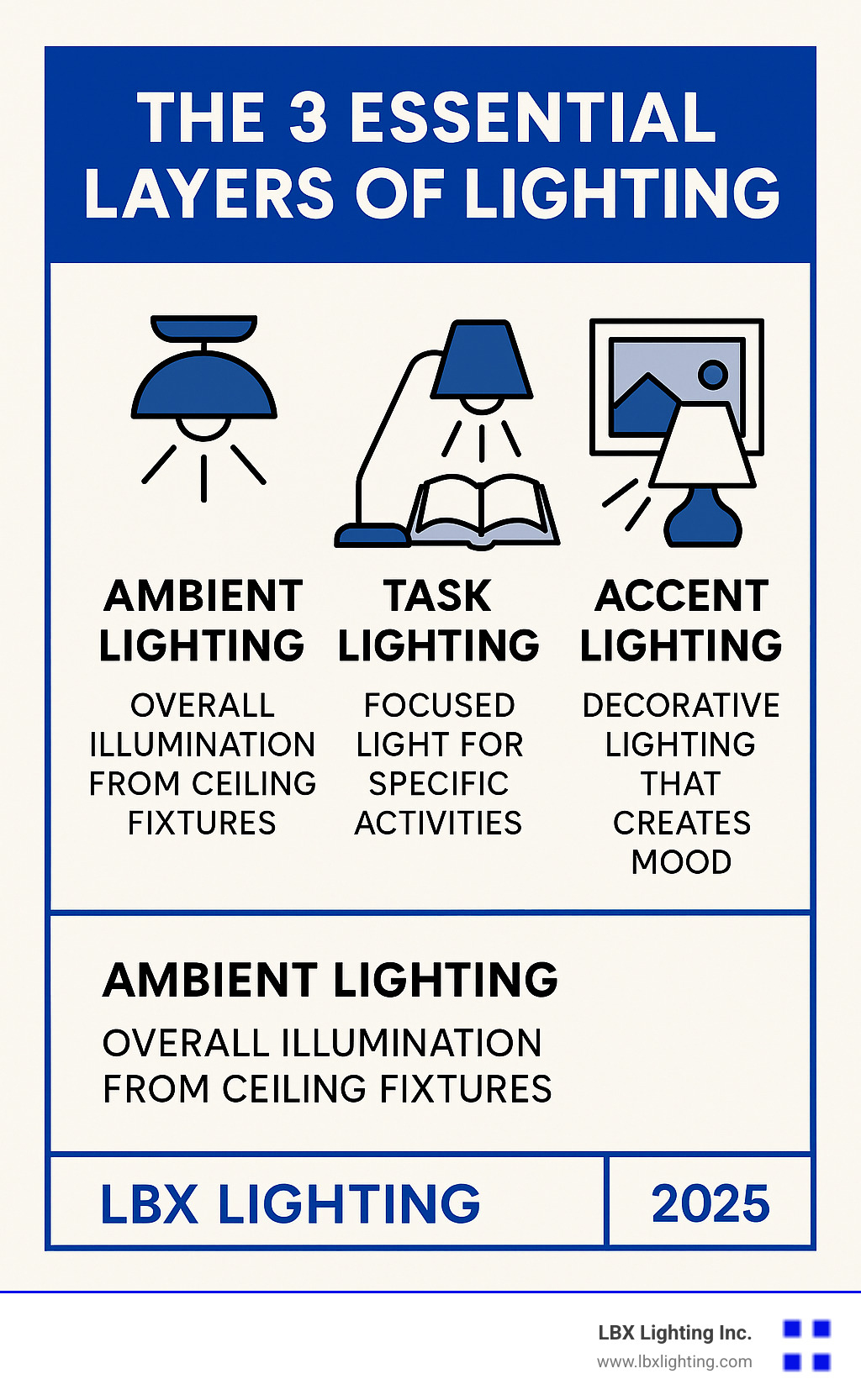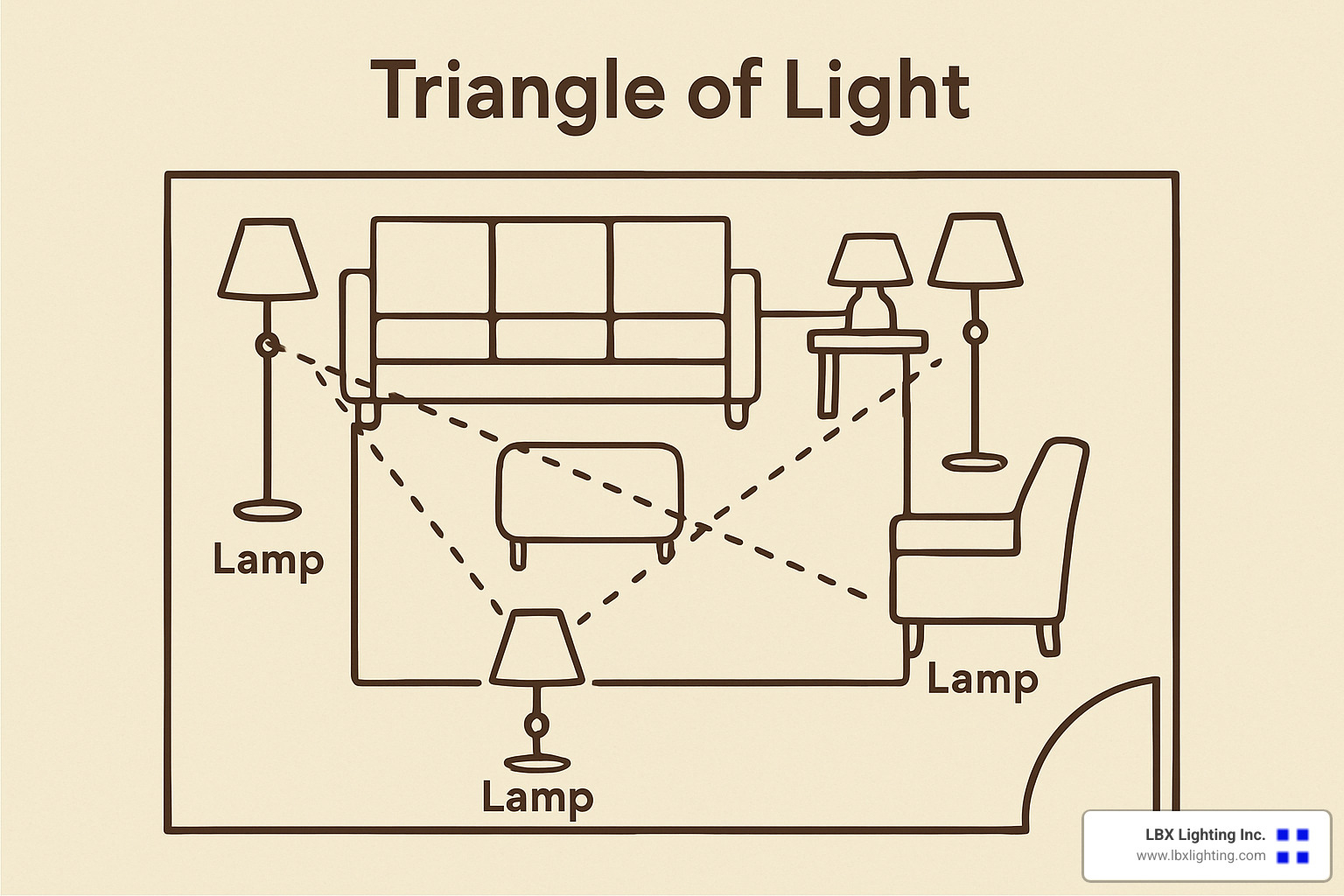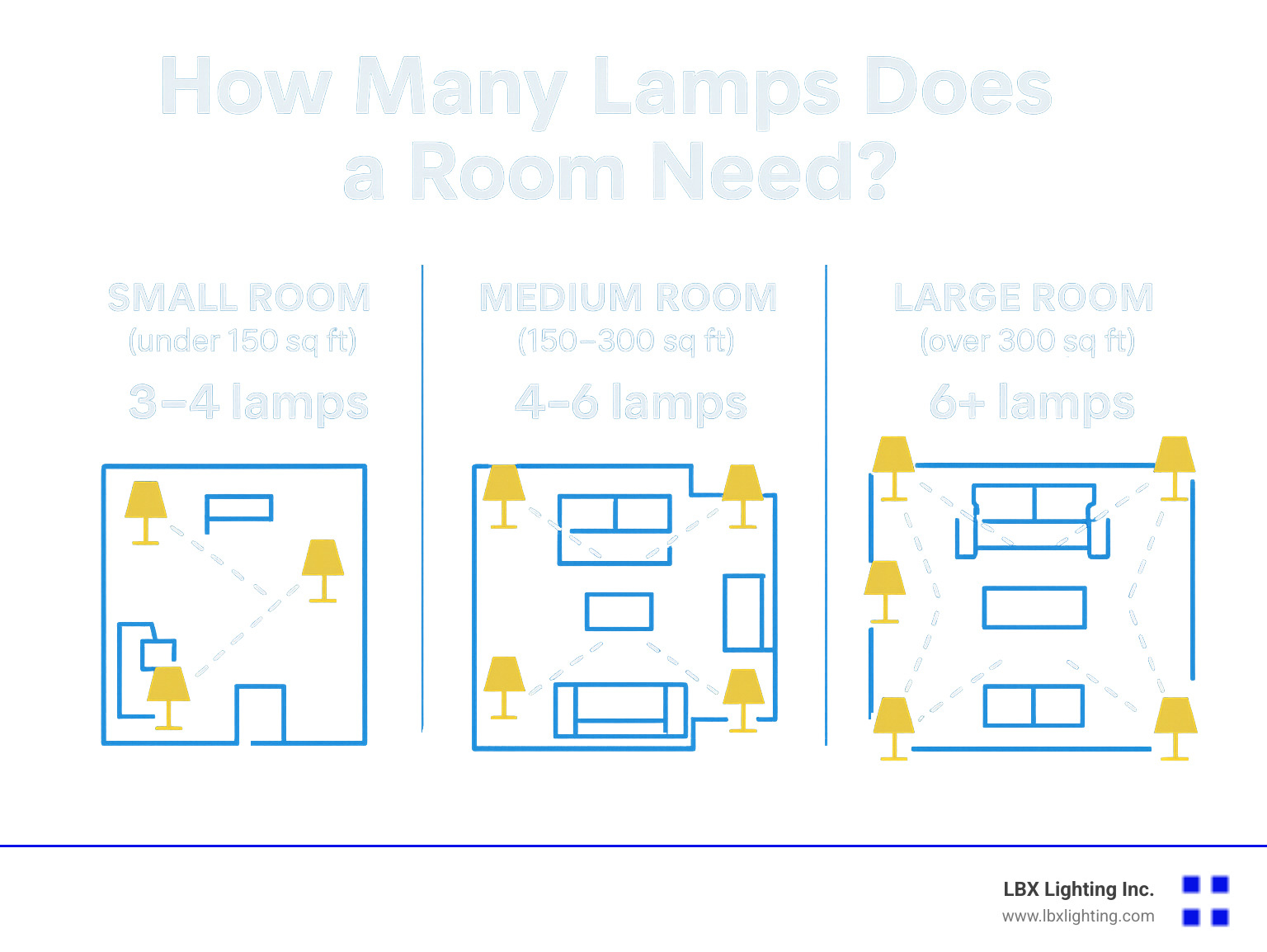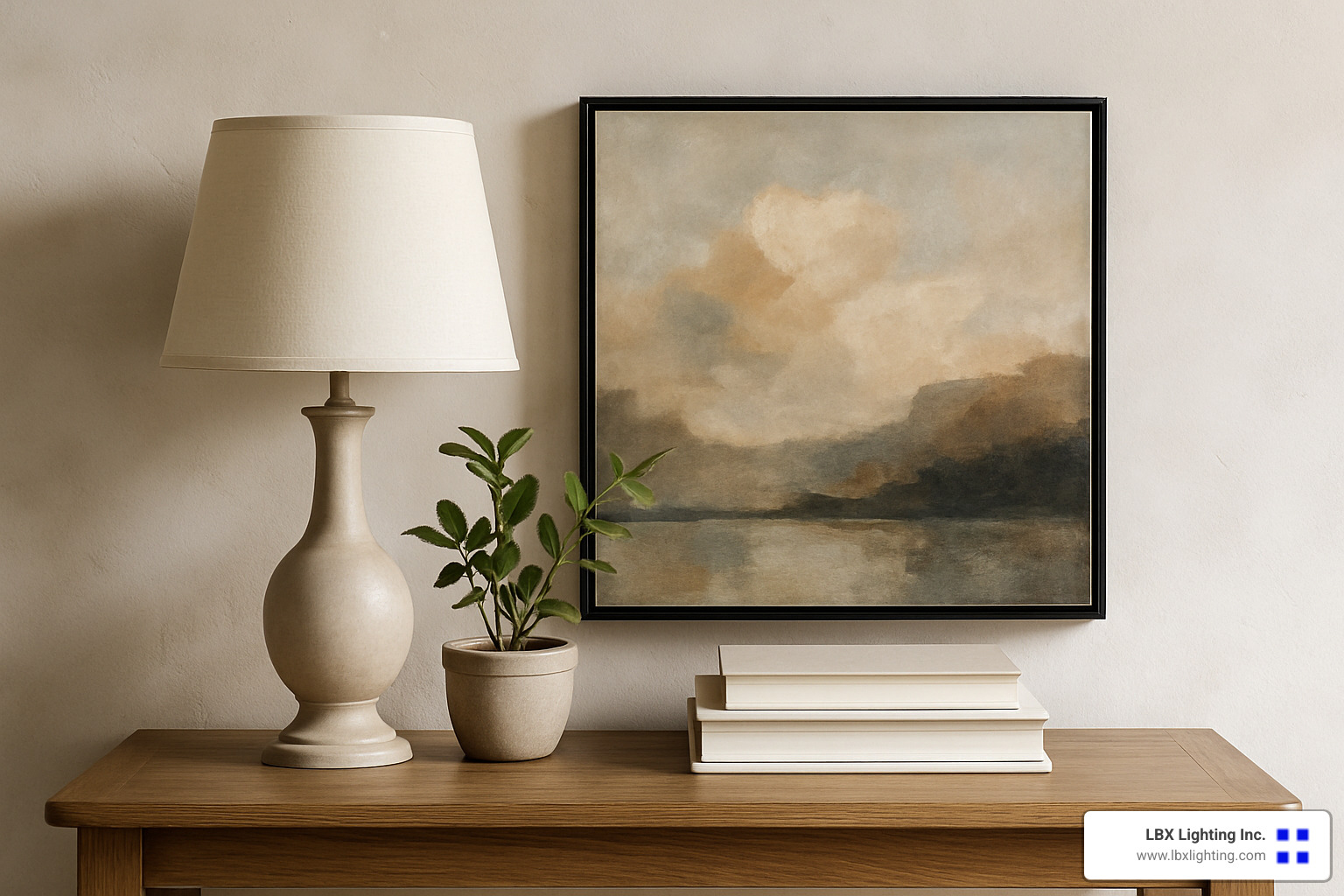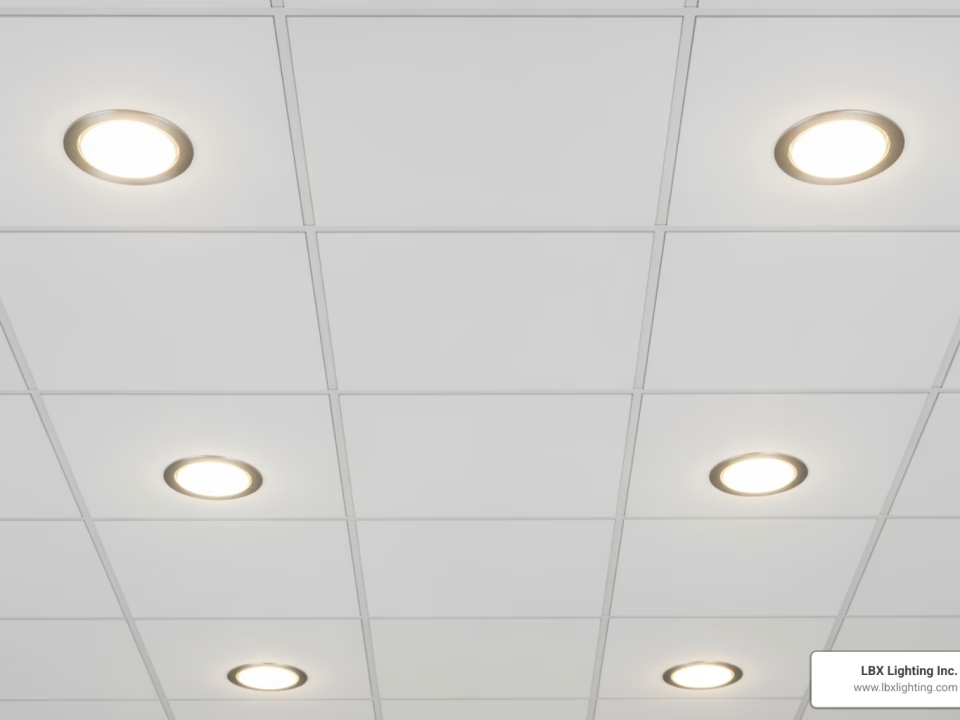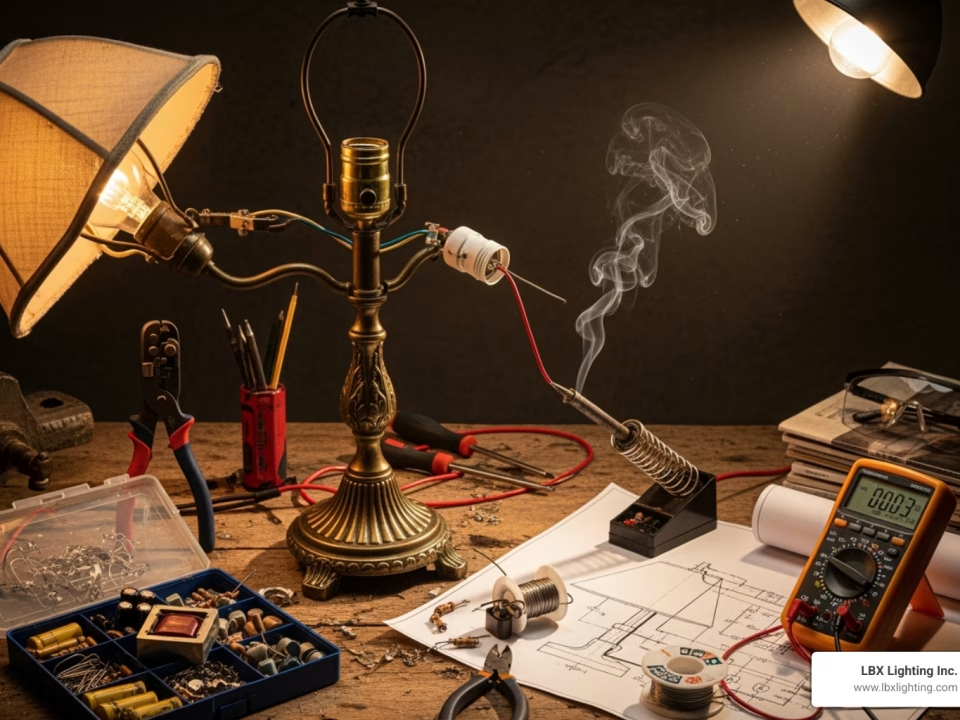
Commercial Track Lighting Solutions That Shine Brightest
July 15, 2025
Shine Bright Like a Diamond—Crystal Chandeliers for Your Dining Room
July 15, 2025Why Decorating with Lamps is Your Secret Weapon for Beautiful Spaces
Decorating with lamps is one of the simplest and most impactful ways to change the way a room looks and feels. More than just sources of illumination, lamps create atmosphere, define distinct spaces within a larger room, and act as functional art. Their greatest advantage is flexibility; they allow you to tailor the light to match any activity, mood, or time of day, something fixed overhead lighting can rarely achieve.
Quick Guide to Decorating with Lamps
- Mood: Warm, eye-level light feels welcoming and intimate, creating a space where people want to gather and relax.
- Size: The right scale is crucial. Most table lamps should fall in the 24-32 inch range. A good rule of thumb for shades is that their height should be about 1/3 of the lamp’s total height.
- Placement: To properly illuminate a room and chase away dark corners, use a “triangle of light” by placing at least three lamps in a triangular pattern.
- Style: The base and shade should complement your room’s existing decor, whether it’s modern, traditional, or eclectic.
- Layering: Don’t let lamps stand alone. Mix them with art, books, and accessories to create beautiful, collected vignettes that tell a story.
As one lighting expert aptly said, “Lamps are the jewelry of a room.” Unlike fixed ceiling fixtures, they are portable pieces of decor that can move wherever your life and needs move. They are essential for a layered lighting plan, which combines ambient (overall), task (focused), and accent (highlighting) light to create a truly dynamic and functional space.
I’m Michael Eftekhar, and for 30 years at LBX Lighting, I’ve watched Houston homeowners completely transform their spaces just by adding the right lamps. The principles below are the same ones we share with our clients, and they will help you do the same in your own home.
The Art of Ambiance: How Lamps Shape Your Room’s Mood
Step into any lamp-lit room and you feel the difference immediately—it’s warmer, more inviting, and more alive. This isn’t just a matter of taste; it’s rooted in psychology. Lamps work because our brains are hardwired to prefer light that comes from eye level or below, a primal comfort that mimics the warm glow of sunsets and campfires. Harsh overhead fixtures, by contrast, cast unflattering, downward shadows that can feel sterile and create glare.
Think of the lobbies and rooms of great hotels: they are masters of ambiance. You’ll rarely find a single, glaring ceiling fixture. Instead, they strategically place four, five, or even more lamps to create pools of warm light, making those rooms feel instantly comfortable and luxurious. The same strategy works wonders at home, turning a simple room into a sophisticated retreat.
How Good Lighting Affects Ambience
Why Choose Lamps Over Overhead Lighting?
While overhead lighting is practical and necessary for functional activities like cleaning or cooking, it often feels clinical and flat for everyday living. Lamps, on the other hand, create pools of light, soft shadows, and visual depth that make a room feel dynamic and interesting. By turning them on in the late afternoon and leaving them on through the evening, you can create a seamless and pleasant transition from day to night. This simple habit helps your home feel consistently warm and welcoming.
Using Lamps to Define and Improve Spaces
Lamps are brilliant tools for carving out functional and beautiful zones within a room:
- Task: A swing-arm floor lamp placed beside a comfortable chair instantly carves out a dedicated reading nook.
- Accent: A small, neat lamp placed on a bookshelf or console table turns a simple collection of books or objects into a curated feature wall.
- Ambient: By combining multiple lamps, you allow their light to overlap and blend. This technique makes large rooms feel more intimate and connected, while in small rooms, it can draw the eye to the corners, making the space feel larger and more spacious.
Floor lamps are particularly versatile. They can fill awkward, empty corners with light and style, add vertical height to a room with low ceilings, and act as an anchor that pulls a disparate furniture plan together in a way ceiling fixtures never could.
Finding the Perfect Fit: A Guide to Lamp Size, Scale, and Style
Lamp selection is like tailoring a suit—proportion and fit are everything. A beautiful, high-quality lamp that’s the wrong size for its location can throw off the balance of an entire room. To avoid this, follow a few simple rules of scale and you’ll rarely go wrong.
| Furniture | Ideal Lamp Height | Why |
|---|---|---|
| End Table | 24-28 in. | The bottom of the shade should be near eye level when you are seated to avoid glare. |
| Console Table | 27-32 in. | Extra height is needed to balance the tall, narrow surface and make a statement. |
| Nightstand | 24-28 in. | This height provides comfortable, glare-free light for reading in bed. |
| Tall Dresser | 18-22 in. | A shorter lamp prevents the composition from feeling top-heavy and cluttered. |
| Floor Lamp | 58-68 in. | This range ensures the light is cast downward and outward effectively for reading or ambient light. |
When in doubt, go slightly bigger. A lamp that feels a little too small, or “dinky,” can look like an afterthought. A lamp that’s an inch or two taller or wider than you expected often looks more intentional and substantial.
Lampshades Simplified
The lampshade is just as important as the base. Here are two simple formulas: the shade height should be about 1/3 of the lamp’s total height, and the shade width should be roughly twice the width of the lamp’s base.
- Shape: Drum shades are incredibly versatile and suit almost any style. Empire shades, which are wider at the bottom, are more traditional and focus light downward. Square or rectangular shades lend a clean, modern edge.
- Material: The material dramatically affects the mood. Linen or cotton shades create a relaxed, casual feel. Silk shades offer a polished, formal look. Paper shades provide a crisp, modern aesthetic. Light-colored shades in white or off-white will provide more ambient light output, while dark shades, especially those with metallic gold or silver liners, create a cozy, dramatic mood without sacrificing brightness.
More on shades from our Houston experts
Timeless Bases & Bulbs
Classic base shapes like gourd, candlestick, and column have endured for decades because they work with a wide range of styles. Choose high-quality materials like ceramic, metal, wood, or glass in finishes that you love—a good lamp is an investment you’ll own for years.
For the bulb, technology has made it easy to get the perfect glow. Use 2700 Kelvin (K) LED bulbs for a warm, incandescent-like light that’s also energy-smart. If you prefer a slightly cleaner, whiter light, choose 3000 K. Reserve cooler temperatures like 4000-5000 K for task-oriented work areas like garages or workshops, as they can feel harsh in living spaces.
Strategic Placement: The Secrets to Effective Decorating with Lamps
A gorgeous lamp in the wrong spot is a wasted opportunity. Effective lamp placement is a strategic exercise that, when done correctly, will banish shadows, create functional zones, and bring a sense of harmony and balance to your room.
How Many Lamps Does a Room Need?
For most rooms, start with the triangle of light. This principle involves placing three lamps in a rough triangular shape around the room. This approach draws the eye across the space and ensures that no single corner feels forgotten or falls into darkness. Most living rooms benefit from at least three to four light sources. Large family rooms or open-concept spaces may need six or more to feel adequately and evenly lit. A good guideline is to aim for a light source about every 10 feet around the perimeter of the room.
Where to Place Lamps
- End tables next to sofas and chairs: These are classic spots, providing great task light for reading and keeping the switch within easy reach.
- Console tables in hallways or behind sofas: Taller, more dramatic statement lamps can anchor the wall and the furniture piece.
- Dark corners: A floor lamp instantly turns “dead space” into an intentional and inviting feature, like a reading spot or a place to highlight a plant.
- Behind or beside the TV: Placing a soft light source near the screen helps reduce eyestrain by softening the contrast between the bright screen and a dark room.
- Entry tables and dining room buffets: A pair of matching lamps creates a gracious, symmetrical welcome for guests.
Pro Tips
Managing cords is key to a polished look. Hide them behind furniture, run them under rugs (using a flat plug), or use decorative cord covers that match your wall color. For ultimate convenience, have an electrician put key outlets on a wall switch, so you can turn on multiple lamps at once. For an easy upgrade, add plug-in dimmers to any lamp for instant mood control. Finally, take a moment to step outside your home at night—your windows should glow invitingly, signaling a warm and well-lit home within.
Develop a complete lighting plan
Advanced Styling: Mixing, Matching, and Creating Vignettes
Once you’ve mastered the basics of size and placement, you can begin to have fun with styling. Treat your lamps like key accessories—they are the finishing touch that pulls the whole outfit of a room together.
Matching vs. Mixing
There are no hard and fast rules here, but these guidelines can help you decide which approach to take:
- Match when you crave symmetry and order. A matched pair of lamps is perfect for flanking a sofa on end tables, on a dining room buffet, on nightstands in a bedroom, or on a console table placed under a large piece of art. This creates a sense of formal balance and calm.
- Mix for a more modern, eclectic, or collected-over-time look. The key to successfully mixing lamps is to maintain some form of cohesion. You can achieve this by linking them through a common color, material, scale, or shade style. For example, you could pair a brass floor lamp with a ceramic table lamp that has a brass base. Or, use two lamps of very different styles but keep their heights and shade shapes similar. This makes the pairing feel intentional, not random.
Building Vignettes
A vignette is a small, curated grouping of objects that tells a story. A lamp is often the perfect anchor for one.
- Start with the lamp as your tallest object, establishing the height of the arrangement.
- Add medium-height items next, such as a stack of two or three coffee table books or a framed photo. Place these to one side of the lamp.
- Place a low, wide object on the other side to create balance. A decorative tray, a small bowl, or a low, trailing plant works perfectly. This forms a loose visual triangle, which is pleasing to the eye.
- Edit your collection. A few well-chosen, meaningful objects will always have more impact than a surface crowded with clutter.
To add more life and texture, consider incorporating candles, small sculptures, or natural elements like a piece of coral or a small vase of flowers. Using a tray is a great designer trick to corral smaller items so the entire arrangement looks purposeful and contained.
Conclusion
Lamps deliver far more than just light—they are one of the most powerful tools in your design arsenal, bringing atmosphere, proportion, and personality to any room. By focusing on a few key principles, you can illuminate your home beautifully and effectively. Remember the essentials:
- Choose warm, inviting light. 2700 K LED bulbs provide instant coziness and are the top choice for living spaces.
- Get the scale right. Stick to the 24-32 inch range for most table lamps, with shades that are about 1/3 of the total lamp height.
- Use the power of three. Place at least three lamps per room—and more in larger spaces—to eliminate dark corners and create a balanced, welcoming glow.
At LBX Lighting in Houston, our expert staff lives and breathes lighting. We can help you apply these ideas to every room in your house, ensuring the result is both beautiful and functional. Visit our showroom to see these principles in action or browse our collections online. Let us help you see how the right lamp can turn any space into the welcoming, stylish home you’ve always imagined.
Explore our full range of residential lighting fixtures
Life’s too short for bad lighting.



